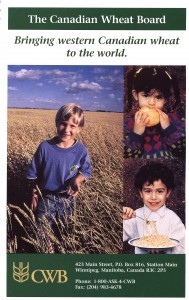 (February 16, 2016) Another family day domino fell this week with the report that a major Canadian food retailer was replacing pasta manufactured with prairie durum with pasta imported from Turkey of all places.
(February 16, 2016) Another family day domino fell this week with the report that a major Canadian food retailer was replacing pasta manufactured with prairie durum with pasta imported from Turkey of all places.
It should be remembered that with the single-desk Wheat Board pretty much all the pasta consumed in Canada was made with prairie durum. The Wheat Board had a policy of keeping competition among durum purchasers alive by equalizing freight costs for processors.
This meant more wheat and durum was milled and made into flour and pasta on the prairies than in the same grain growing areas of the United States. It also meant that the big eastern flour and pasta plants in Ontario used prairie wheat. It was a very profitable premium market for prairie farmers and took somewhere around 20% of our annual production of wheat and durum wheat.
This Wheat Board policy meant that essentially all the bread, pasta, and most of the beer in Canada was made with prairie wheat and barley. As this organization warned in 2011 “the end of the Wheat Board means the end of local food.”
Now the Wheat Board is gone along with its policies encouraging local processing. Combine this with very cheap ocean freight and it is apparently more economic for eastern retailers to buy Turkish pasta than it is to purchase locally produced pasta made with prairie durum. Ocean freight on 4,800 nautical miles from Turkey is apparently cheaper than dealing with the uncertain and unreliable private trade to acquire grain 3,300 miles away on the southern Canadian prairies.
Some Canadian pasta processors have complained this Turkish pasta is subsidized, and that may well be the case. However that ultra cheap ocean freight may also mean that sourcing wheat from the Ukraine, which is a mere 600 nautical miles away is now more economic than importing even heavily discounted prairie durum.
Speaking of Canada’s southern prairies, it was three years ago, on Family Day, that the giant American firm, Archer Daniels Midland announced it was closing its flour mill at Medicine Hat, in the center of prairie wheat country, and consolidating operations in Calgary.
The family day hits from the abusive and short-sighted Harper regime just keep on coming for Canadian families and the prairie farmers who work to feed them.


Are you kidding me????? Great plan let’s put more Canadians out of work, awesome. Let’s buy pasta from overseas when we produced it here wtf is wrong with that equation…
Let us know which retailer so we can boycott them. I only want to buy Canadian products.
Hi Elaine:
The short answer is it looks like you need to look for “Product of Canada” on the package.
For more information, the Canadian Food Inspection Agency controls the labelling of food in Canada. They have a web site on the subject here: http://www.inspection.gc.ca/food/labelling/food-labelling-for-consumers/eng/1400426541985/1400455563893
And here is their explanation of how to shop for Canadian source food: http://www.inspection.gc.ca/food/labelling/food-labelling-for-consumers/canadian-food/eng/1409065542798/1409065599130
Here is what the CFIA says on this page today:
Product of Canada
A “Product of Canada” label means that all, or nearly all, of the food, processing and labour used to make the food is Canadian. These foods were
• grown or raised by Canadian farmers, and
• prepared and packaged by Canadian food companies.
A food can still be labelled “Product of Canada” if it contains small amounts of imported food, such as spices, food additives, vitamins, and flavorings.
Made in Canada from domestic and imported ingredients
The words “Made in Canada from domestic and imported ingredients” on a food label mean that
• a Canadian company was involved in some of the preparation of the food, and
• it contains some food grown by Canadian farmers, and some food that’s been imported.
Made in Canada from imported ingredients
The words “Made in Canada from imported ingredients” on a food label means that
• a Canadian company was involved in some of the preparation of the food; and
• the contents of the food were imported.
It’s going to get worse with the TPP. Please let us know brands with Canadian wheat and grains.I support Canadian crop farmers but not animal agriculture. We need to stop using animals for food. The next big thing will be the demand for organic grains, veggies, legumes etc.
Rather than look at brands, it is better to check the package label because the contents can be changed depending on the supply of the raw product, so always read the content label. See the detailed answer above.
The TPP is certainly a problem and most farmers are very concerned about its implications for food security and their ability to produce the wholesome food people deserve especially when it comes to public plant breeding which you can read about here: http://www.cwbafacts.ca/public-plant-breeding/
Here is an overview article on the TPP as well with lots of good links.
http://www.cwbafacts.ca/2015/12/producing-poverty/